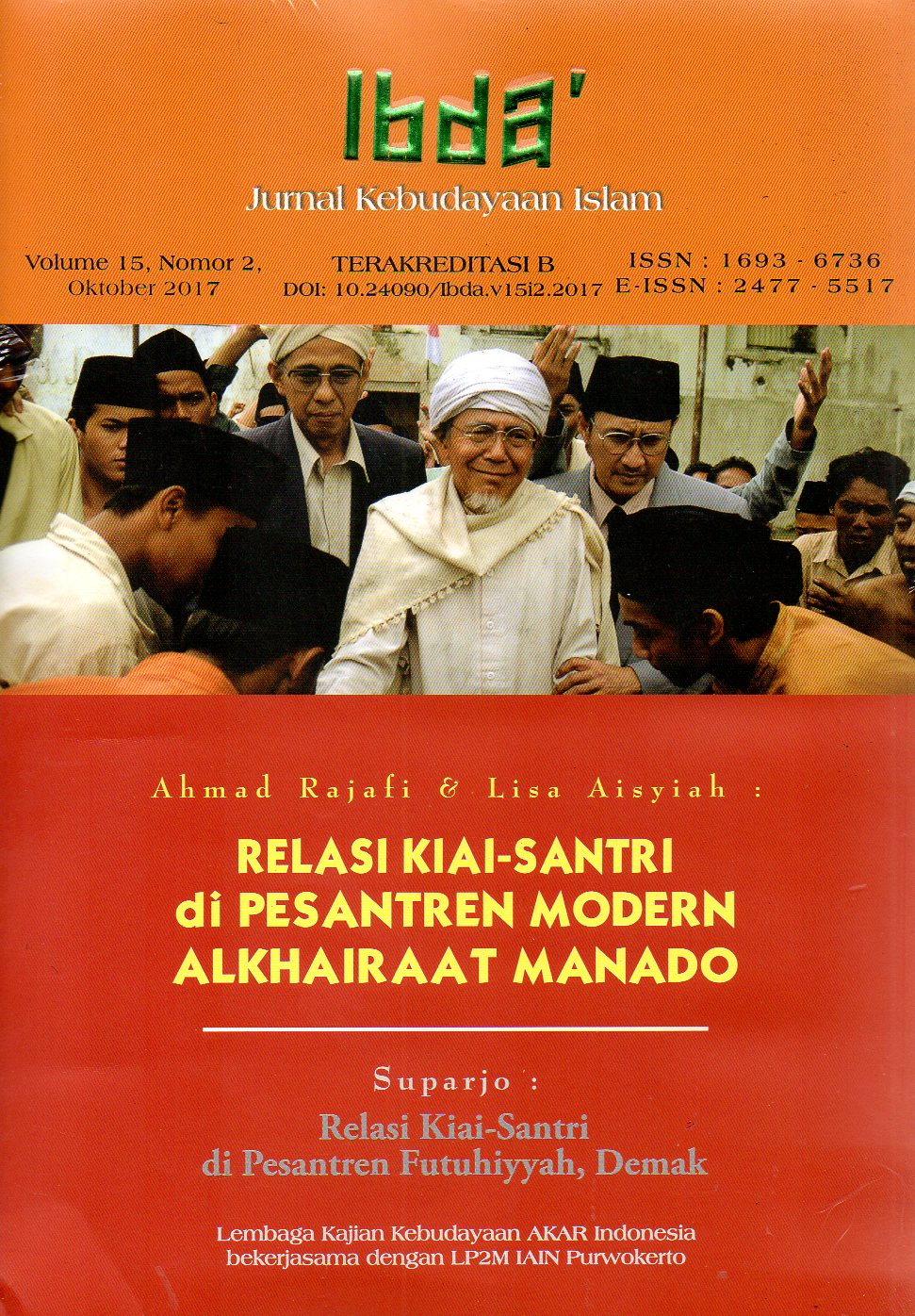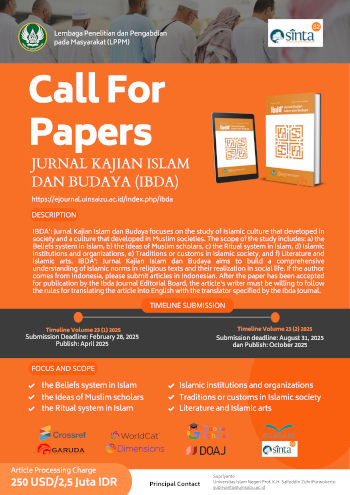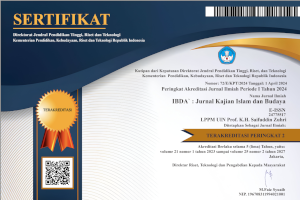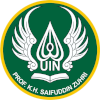AKOMODASI PESANTREN PADA KESENIAN RAKYAT DI CANGKRINGAN, SLEMAN, YOGYAKARTA
DOI:
https://doi.org/10.24090/ibda.v15i2.1334Keywords:
Islam, Folk Art, Accomodation, al-Qodir Islamic Boarding SchoolAbstract
This study investigated the construction of thoughts by KH. Ahmad Masrur and al-Qodir Islamic Boarding School to accomodate folk art; to reveal the relationship among KH. Ahmad Masrur, al-Qodir Islamic Boarding School, and folk art communities in Wukirsari village; and to find out the approaches of accommodation implemented in the folk art Village. The findings of this study led to some conclusions. First, on the one hand, Mr. Masrur (an Islamic expert) wanted to send the goodness and the beauty of Islam not only to be achieved by Moslems but also by other religious community. On the other hand, the folk art community wanted to maintain their existence in the diverse society. Therefore, those two intentions are linked to each other in order to accomplish those goals. Second, the relationship among Mr. Masrur, al-Qodir Islamic Boarding School, and Wukirsari village folk art community; in terms of historical context, it was the repetition of the relationship pattern in the past time that occured during the Islamisation process in Java. It was carried out by placing the locality as the basis of Islam. Mr. Masrur, al-Qodir Islamic Boarding School put themselves as the exponents of folk art; Mr. Masrur had the role as the patron and the community folk art had the role as the clients, and the overall relationship was accomplished based on mutually beneficial relationship. Third, the forms of accommodation roposed by Mr. Masrur towards folk art in Wukirsari village were through compromise and tolerance. The form of the compromise was visible through the willingness of both parties to feel and understand the circumstances of one to each other party. As for the form of tolerance, it was implemented by Mr. Masrur and al-Qodir Islamic Boarding School deliberately to avoid various disputes and conflicts.Downloads
Download data is not yet available.
References
Abdullah, Irwan. 2006. Konstruksi dan Reproduksi Kebudayaan. Yogyakarta:Pustaka Pelajar.
Arifin, Achmad Zainal.2013. “Charisma and Rationalisation in ModernisingPesantren: Changing Values in Traditional Islamic Education in Javaâ€.Disertasi. Religion and Society Research Centre University of WesternSydney, Australia.
Beatty, Andrew. 2001. Variasi Agama di Jawa suatu Pendekatan Antropologi,Terj. Achmad Fedyani Saefudin. Jakarta: PT Raja Grafindo Persada.
Dhofier, Zamaksyari. 2009. Tradisi Pesantren Memadu Modernitas UntukKemajuan Bangsa. Yogyakarta: Pesantren Nawesea.
Dhofier, Zamakhsyari. 1994. Tradisi Pesantren Studi tentang Pandangan HidupKyai. Jakarta: LP3ES.
Fazlurrahman. 2000. Islam. Terj. Ahsin Mohammad, Bandung: Pustaka.
Friedmen, Jonathan. 1991. “Being in the World: Globalization and Locali-zationâ€. Dalam Mike Featherstone (ed.). Global Culture: Nationalism,Globalization and Modernity. London: Sage Publications.
Feillard, Andree. 1999. NU Vis a Vis Negara: Pencarian Isi, Makna dan Bentuk.Edisi terjemah. Yogyakarta: LKiS.
Hadi, Sumandiyo Y. 2006. Seni dalam Ritual Agama. Yogyakarta: BukuPustaka.
Hanif, Muh. 2005. “Dakwah Islam Kultural (Studi atas Apresiasi Kiai MasrurAhmad MZ (Lahir 1963) Terhadap Kesenian Jatilan Di KelurahanWukirsari Cangkringan Sleman Yogyakarta)â€. Tesis. Yogyakarta: CRCS,Universitas Gadjah Mada.
Haryatmoko. 2008. Konsep Habitus Pierre Bourdieu: Mekanisme dan StrategiDominasi, Handout. PPS. UIN Sunan Kalijaga.Laode Ida. NU Muda Kaum Progresif dan Sekularisme Baru. Jakarta: Erlangga,2004.
Khadziq. 2009. Islam dan Budaya Lokal Belajar Memahami Realitas Agamadalam Masyarakat. Yogyakarta: TERAS.
Koentjaraningrat. 1980. Pengantar Ilmu Antropologi. Jakarta: Aksara Baru.
_____________. 2005. Pengantar Antropologi pokok-pokok etnografi II.Jakarta: PT Rineka Cipta.
Liliweri, Alo. 2007. Makna Budaya dalam Komunikasi Antar Budaya.Yogyakarta: LkiS.
Mas’ud, Abdurrahman. 2004. Intelektual Pesantren Perhelatan Agama danTradisi. Yogyakarta: LKiS.
M, Abdurrahman. 2011. “Islam Aboge: Harmoni Islam dan Tradisi Jawaâ€.Dipresentasikan dalam the Annual Conference on Islamic Studies,Bangka Belitung, Oktober.
Nuril dan Rosyadi, Khoerul. 2010. Ritual Gus Dur dan Rahasia Kewaliannya.Yogyakarta: Galangpress.
Pranowo, Bambang. 2009. Memahami Islam Jawa. Jakarta: Pustaka Alvabeta.
Soekanto, Soerjono. 2006. Sosiologi: Suatu Pengantar. Yogyakarta: RajaGrafindo Persada.
Setyawan, Agus. 2008. “Konsep Seni Islami Seyyed Hossein Nasr, Telaahatas Signifikansi Hubungan Seni dan Spiritualitas di Dunia Modernâ€.Tesis Yogyakarta: UIN SUKA.
Shri Ahimsa-Putra, Heddy. 2001. Strukturalisme Levi-Strauss Mitos dan KaryaSastra. Yogyakarta: Galang Press.
Thohir, Mudjahidin. 2005. Orang Islam Jawa Pesisiran. Semarang: FASINDOPress.
Wahyono, Sugeng Bayu, Dkk.2005. Pesantren, Radikalisme, dan konspirasiGlobal. Jakarta: INPEDHAM.
Woodward, Mark R. 2008. Islam Jawa Kesalehan Normatif versus Kebatinan.Yogyakarta: LKiS.
Wertheim, W.F. 1999. Masyarakat Indonesia dalam Transisi: Kajian PerubahanSosial. Yogyakarta: Tiara Wacana.
Arifin, Achmad Zainal.2013. “Charisma and Rationalisation in ModernisingPesantren: Changing Values in Traditional Islamic Education in Javaâ€.Disertasi. Religion and Society Research Centre University of WesternSydney, Australia.
Beatty, Andrew. 2001. Variasi Agama di Jawa suatu Pendekatan Antropologi,Terj. Achmad Fedyani Saefudin. Jakarta: PT Raja Grafindo Persada.
Dhofier, Zamaksyari. 2009. Tradisi Pesantren Memadu Modernitas UntukKemajuan Bangsa. Yogyakarta: Pesantren Nawesea.
Dhofier, Zamakhsyari. 1994. Tradisi Pesantren Studi tentang Pandangan HidupKyai. Jakarta: LP3ES.
Fazlurrahman. 2000. Islam. Terj. Ahsin Mohammad, Bandung: Pustaka.
Friedmen, Jonathan. 1991. “Being in the World: Globalization and Locali-zationâ€. Dalam Mike Featherstone (ed.). Global Culture: Nationalism,Globalization and Modernity. London: Sage Publications.
Feillard, Andree. 1999. NU Vis a Vis Negara: Pencarian Isi, Makna dan Bentuk.Edisi terjemah. Yogyakarta: LKiS.
Hadi, Sumandiyo Y. 2006. Seni dalam Ritual Agama. Yogyakarta: BukuPustaka.
Hanif, Muh. 2005. “Dakwah Islam Kultural (Studi atas Apresiasi Kiai MasrurAhmad MZ (Lahir 1963) Terhadap Kesenian Jatilan Di KelurahanWukirsari Cangkringan Sleman Yogyakarta)â€. Tesis. Yogyakarta: CRCS,Universitas Gadjah Mada.
Haryatmoko. 2008. Konsep Habitus Pierre Bourdieu: Mekanisme dan StrategiDominasi, Handout. PPS. UIN Sunan Kalijaga.Laode Ida. NU Muda Kaum Progresif dan Sekularisme Baru. Jakarta: Erlangga,2004.
Khadziq. 2009. Islam dan Budaya Lokal Belajar Memahami Realitas Agamadalam Masyarakat. Yogyakarta: TERAS.
Koentjaraningrat. 1980. Pengantar Ilmu Antropologi. Jakarta: Aksara Baru.
_____________. 2005. Pengantar Antropologi pokok-pokok etnografi II.Jakarta: PT Rineka Cipta.
Liliweri, Alo. 2007. Makna Budaya dalam Komunikasi Antar Budaya.Yogyakarta: LkiS.
Mas’ud, Abdurrahman. 2004. Intelektual Pesantren Perhelatan Agama danTradisi. Yogyakarta: LKiS.
M, Abdurrahman. 2011. “Islam Aboge: Harmoni Islam dan Tradisi Jawaâ€.Dipresentasikan dalam the Annual Conference on Islamic Studies,Bangka Belitung, Oktober.
Nuril dan Rosyadi, Khoerul. 2010. Ritual Gus Dur dan Rahasia Kewaliannya.Yogyakarta: Galangpress.
Pranowo, Bambang. 2009. Memahami Islam Jawa. Jakarta: Pustaka Alvabeta.
Soekanto, Soerjono. 2006. Sosiologi: Suatu Pengantar. Yogyakarta: RajaGrafindo Persada.
Setyawan, Agus. 2008. “Konsep Seni Islami Seyyed Hossein Nasr, Telaahatas Signifikansi Hubungan Seni dan Spiritualitas di Dunia Modernâ€.Tesis Yogyakarta: UIN SUKA.
Shri Ahimsa-Putra, Heddy. 2001. Strukturalisme Levi-Strauss Mitos dan KaryaSastra. Yogyakarta: Galang Press.
Thohir, Mudjahidin. 2005. Orang Islam Jawa Pesisiran. Semarang: FASINDOPress.
Wahyono, Sugeng Bayu, Dkk.2005. Pesantren, Radikalisme, dan konspirasiGlobal. Jakarta: INPEDHAM.
Woodward, Mark R. 2008. Islam Jawa Kesalehan Normatif versus Kebatinan.Yogyakarta: LKiS.
Wertheim, W.F. 1999. Masyarakat Indonesia dalam Transisi: Kajian PerubahanSosial. Yogyakarta: Tiara Wacana.
Published
2017-10-18
How to Cite
Mawardi, K. (2017). AKOMODASI PESANTREN PADA KESENIAN RAKYAT DI CANGKRINGAN, SLEMAN, YOGYAKARTA. IBDA` : Jurnal Kajian Islam Dan Budaya, 15(2), 284–296. https://doi.org/10.24090/ibda.v15i2.1334
Issue
Section
Articles
License
Authors who publish with this journal agree to the following terms:
- Authors retain copyright and grant the journal right of first publication with the work simultaneously licensed under a Creative Commons Attribution-ShareAlike License a that allows others to share the work with an acknowledgement of the work's authorship and initial publication in this journal.
- Authors are able to enter into separate, additional contractual arrangements for the non-exclusive distribution of the journal's published version of the work (e.g., post it to an institutional repository or publish it in a book), with an acknowledgment of its initial publication in this journal.
- Authors are permitted and encouraged to post their work online (e.g., in institutional repositories or on their website) before and during the submission process, as it can lead to productive exchanges, as well as earlier and greater citation of published work (See The Effect of Open Access).
















